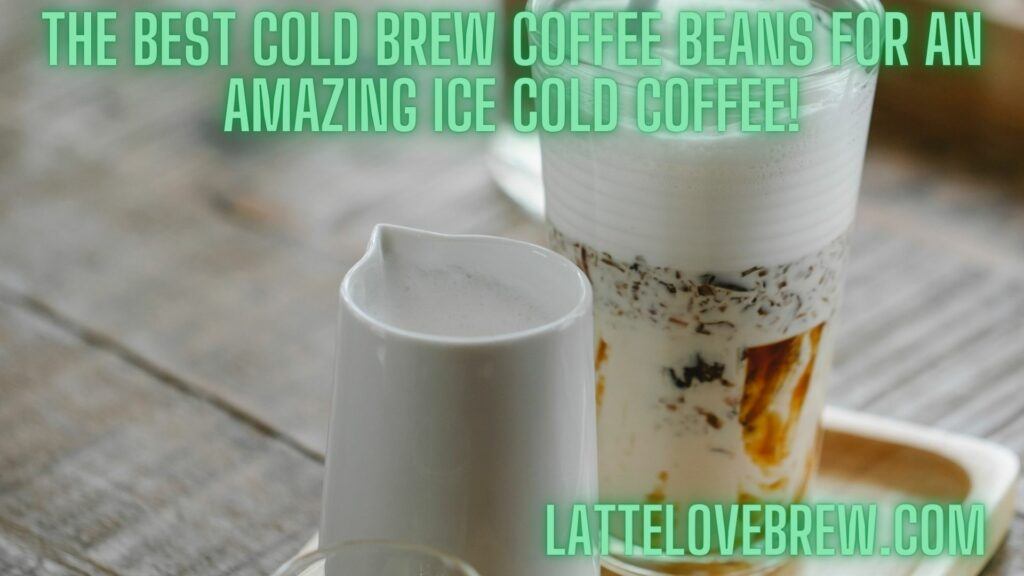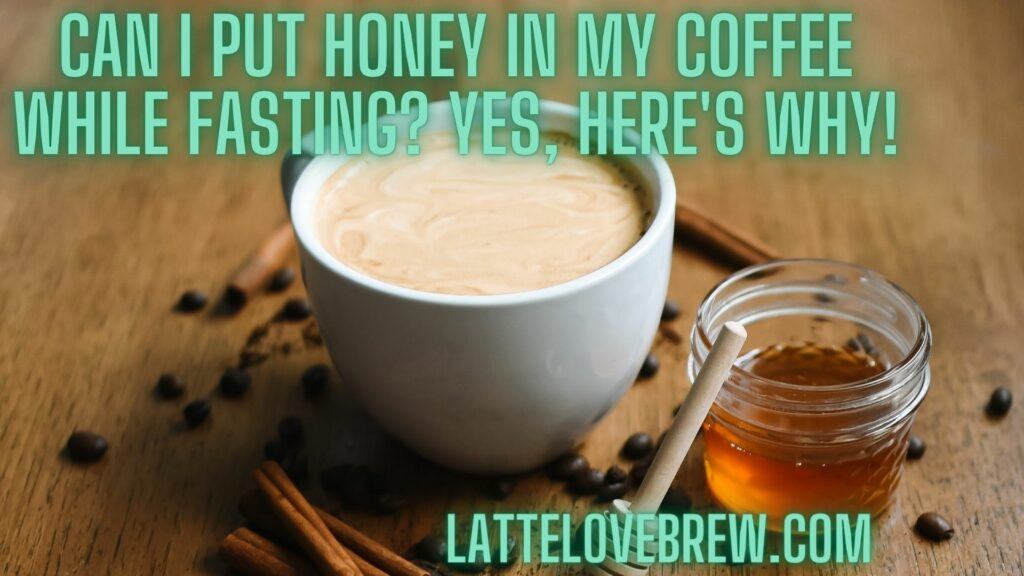Last updated on May 28th, 2024 at 10:41
Using the best cold brew coffee beans will result in you sipping and enjoying the very best possible cold brew coffee. It is the Ferrari principle that we swear by. Use the best ingredients, the best equipment and the best brewing techniques and methods, and you will brew the best coffee.
It is that simple.
By the time you have finished reading this article, you will know all about cold brew coffee beans and what the best ones are that you can use to make an amazing cold brew coffee.
Keep reading as we dig down and detail this topic.
What Is Cold Brew Coffee?
Table Of Contents
- 1 What Is Cold Brew Coffee?
- 2 What Are The Top 10 Best Cold Brew Coffee Beans
- 2.1 #1 Lifeboost Organic Light Roast Coffee Beans. The Healthiest Option
- 2.2 #2 Stone Street Coffee Dark Roast.
- 2.3 #3 Coffee Bros Cold Brew Blend.
- 2.4 #4 Brandywine Coffee Roasters Ethiopia Yirgacheffe – Best Single Origin
- 2.5 #5 Koffee Kult Dark Roast Coffee Beans
- 2.6 #6 Tiny Footprint Coffee Organic Cold Press Elixir. Best Environmental Option.
- 2.7 #7 Lavazza Whole Bean Blend – The Best Decaffeinated Option.
- 2.8 #8 Olde Brooklyn Coffee French Roast Whole Bean Coffee
- 2.9 #9 Café Du Monde Coffee With Chicory.
- 2.10 #10 Cold Brew Lab – The Best Budget Choice
- 3 What Kind Of Coffee Beans Are Best For Cold Brew Coffee?
- 4 Frequently Asked Questions About Cold Brew Coffee Beans
- 5 What Coffee Beans Are Good For Cold Brew?
- 6 Frappé-Ing It All Up – Cold Brew Coffee Beans
Cold brew is a coffee that is brewed using cold water. The use of cold water is intentional so that the barista or coffee brewer can extract the low temperature compounds from the coffee grounds.
The cold water extraction, ideally, ice-cold or as cold as possible to ensure the best possible flavor for a coffee of this style. The brew time can range from 12 hours to 24 hours or slightly longer.
The coffee to water ratio is also much more focused and concentrated than other brewing techniques and produces a bold flavor, and still draws out the subtle flavors from the coffee beans. It is a summer favorite due to the smooth, rich yet bold flavor.
The flavor profile is very different from a coffee made with the same beans, same grind size and a hot water extraction.
There are a couple of ways of brewing a cold brew. Let’s talk about those.
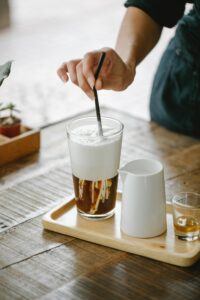
Read: Espresso roasting
Cold Brewing Methods
There are two main ways of brewing cold brew coffee which are by either full immersion or drip cold brew, also known as Kyoto cold brew, Japanese cold brew or full immersion cold brew and Japanese flash cold brew.
Each of these brewing techniques has their own very different processes, brewing time and flavor profile. It also affects the cold brew concentrate.
The two cold brewing methods have the need for different equipment. As the name suggests, full immersion requires you to steep your coffee beans, while the other is a long, slow and very drawn-out drip brewing method.
The one thing the two methods have in common is they produce a great cold brew coffee that is brewed using cold water. Both also have a subtle flavor profile and low acidity and use coarse coffee grounds.
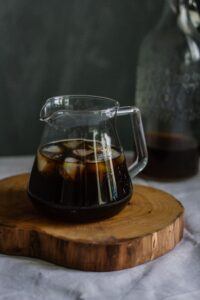
Read: How to make strong coffee
Immersion Or Full Immersion Cold Brew
Full immersion cold brew requires you to own very little (if any!) brewing equipment while you steep your cold brew coffee beans that are of a coarse ground for anything from 12-24 hours and often slightly longer. When it is ready, simply filter out the coffee grounds. Never leave your grounds in your full immersion cold brew as they will continue to extract.
Pro Tip: Taste and sip test your cold brew after 12 hours and every 4 hours thereafter. Stop once it hits the sweet spot for you.
This is a cold brewing method that allows you to improvise as all you need is a mason jar or practically any glass jar that has an airtight lid. A plastic container is not ideal because coffee is acidic and can draw out the toxic unhealthy chemicals from the plastic and get them into your coffee.
An airtight lid is a must as your coffee will absorb the odor and flavors from nearby food items.
Other items are filtered water that is as cold as possible. I like to ice my water by either adding ice or putting it in the freezer until it is just below the freezing point.
The full immersion technique is the most popular method and is also used to brew batches of cold brew concentrate. For cold brew concentrate. Simply brew your coffee two or three times with fresh grounds on each cycle. The benefit of a concentrate is it lasts longer before going off. It has a better shelf life.
Drip Cold Brew, Also Known As Japanese Flash Cold Brew
Drip cold brew coffee, or Japanese flash cold brew coffee, is a cold brewing process that originates in the city of Kyoto, Japan and is VERY different from the full immersion cold brew technique that we spoke about above.
The method is somewhat of a drip coffee meets a cold brew. Your ice-cold water, slowly and at an event rate, drips into an area where your freshly ground coffee grounds are, which is then filtered into and collected by a carafe at the bottom.
It is just as long a process that can take anything from 6 hours to 12 hours to brew. It is a very beautiful piece of equipment that will look amazing in your home, even when you are not brewing your coffee.
Most coffee lovers I know own one of these cold brew coffee makers. I even bought one for my friend’s coffee shop as it looks amazing when on display.

What Cold Brew Coffee Is Not
Cold brew coffee is not coffee with ice or iced coffee. These are two very different coffees and produce a different flavor profile. They are prepared in a very different way.
Unfortunately, this is how many coffee chains and even smaller independently owned coffee shops view cold brew. Ask for a cold brew, and you can end up with a coffee that is brewed hot with some ice cubes in it, which is regular coffee with ice.
What Are The Top 10 Best Cold Brew Coffee Beans
Let’s get you brewing the best possible cup of coffee with the best cold brew coffee beans that will produce a rich flavor that you will enjoy.
#1 Lifeboost Organic Light Roast Coffee Beans. The Healthiest Option
This 100% Arabica Nicaraguan single-origin bean is hand picked and spring water washed. They are organic, pesticide and mycotoxin free. This coffee company is highly focused on producing the healthiest coffee and in a very ethical and environmentally friendly way.
Light roast coffee is acidic but, when you cold brew for 16 hours or more, you will reduce the acidity and have a smooth flavor from these rather exotic tasting coffee beans.
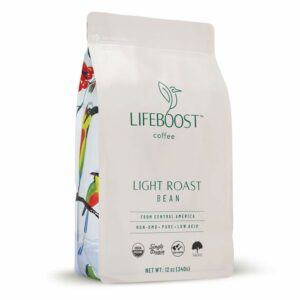
#2 Stone Street Coffee Dark Roast.
Stone Street started out as a small single location roastery in Brooklyn, New York and grew into a huge coffee empire and is now well known for their excellent and well roasted coffee beans.
This dark roasted Colombian blend when you make a cold brew with it is creamy, rich and pure. It also makes an outstanding iced coffee. It goes very well naked as it is or with a dash of cream or milk.
This coffee is 100% Colombian Supremo coffee beans.
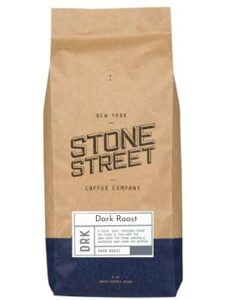
#3 Coffee Bros Cold Brew Blend.
This company, Coffee Bros, founded by two brothers, is a relatively new company and stands out for their commitment to quality sourcing of their beans and the attention to detail in their roasting by roasting only small batches at a time.
This cold brew blend is a medium roast and has an emphasis on the juicy and sweet flavors. The result is a very refreshing cold brew coffee.
The coffee beans are 100% Arabica beans and is a blend of my favorite Ethiopian Yirgacheffe coffee beans and Brazilian coffee from Minas Gerais. Coffee Bros prefers to use beans that are naturally processed due to their higher level of natural sweetness. The beans are then very carefully roasted during the roasting process to highlight their natural character.
The result is a coffee with a brown sugar, berry and chocolate profile. It has a very intense aroma.
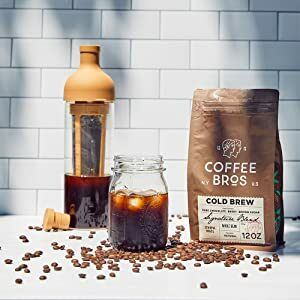
#4 Brandywine Coffee Roasters Ethiopia Yirgacheffe – Best Single Origin
Ethiopian Yirgacheffe is a coffee that I love. It is my favorite coffee for all coffee drinks that I enjoy, both with milk and without.
These coffee beans, this particular coffee is a personal taste of mine that I really enjoy. Try it.
These beans are grown where coffee originated and cultivated at an elevation of 1,400 meters. The beans are dried for a couple of days then dried on raised beds. It’s single-origin beans that are light and have notes and tons of coconut and raspberry.
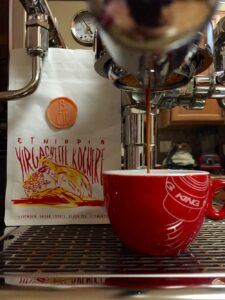
#5 Koffee Kult Dark Roast Coffee Beans
This is another dark roast that steeps well with the full immersion cold brew technique and works brilliantly with very cold water. It has a taste profile that, as a coffee lover, I think you will enjoy the subtle cinnamon and cocoa notes. Cold brew is only one option with Koffee Kult dark roast as you can enjoy a wide range of coffee drinks that are brewed hot and cold.
#6 Tiny Footprint Coffee Organic Cold Press Elixir. Best Environmental Option.
This roastery, Tiny Footprint Coffee, is the first in the world to produce carbon-negative coffee and has a focus on making their coffee that does not have a negative impact on our planet.
For every kilo of coffee sold, they offset the carbon impact by planting new trees in Ecuador’s cloud forest through their partner program.
This cold press elixir is roasted with a specific focus on being used for cold-brewed coffee. It is a blend of dark roast and light roasted beans with top quality Ethiopian coffee beans that produce a cocoa-like body and floral tones with bright fruity notes.
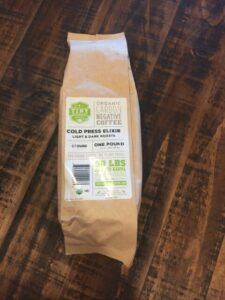
#7 Lavazza Whole Bean Blend – The Best Decaffeinated Option.
Lavazza is a coffee brand that you can trust to make great coffee. They are a trusted centuries old coffee brand from Italy that has won an incredible number of awards over the years. Decaffeinated coffee is not something that is readily enjoyable as many get it wrong, so wrong, and you will end up with a watery coffee that is weak in flavor.
Not these decaf coffee beans.
While I am not a big fan of decaffeinated coffee, I am known to enjoy a cup of coffee late in the evening or at night and when I do, it is decaffeinated.
Lavazza uses a process where their green coffee beans are stream treated. The caffeine is removed using carbon dioxide. This process helps to retain the integrity of the coffee beans while removing all traces of the caffeine.
This is in contrast to the washing process, which does not remove all the caffeine, nor retain the integrity of the beans.
The caffeine coffee beans are then hot air roasted and roasted to produce a decaffeinated coffee that has a fuller body and a better, more complete taste.
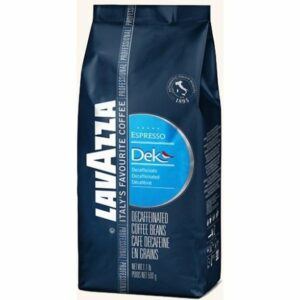
#8 Olde Brooklyn Coffee French Roast Whole Bean Coffee
This coffee has a higher level of acidity and a full-bodied sweet and smoky aroma flavor. It is a 100% Arabica coffee with minimal bitterness.
#9 Café Du Monde Coffee With Chicory.
As the name and language indicate, this is a French coffee shop. They have been in operation since 1862 and operating out of New Orleans. Tourists love it for the chicory tones. The benefit of the chicory helps to create a softer, smoother bitterness of the dark roast.
The sweet aroma that is said to be like tobacco smoke enhances the flavor profile of cold brew coffee. Smooth, mellow and light bodied is what you can expect.
#10 Cold Brew Lab – The Best Budget Choice
This is another coffee that is specifically and purposely roasted for cold brewing coffee. It has a balance in acidity and smoothness, making it great if you have a sensitive stomach. The blend of 100% Arabica USDA-certified organic Colombian coffee beans are available in natural flavors like pumpkin spice, Tahitian vanilla, creamy coconut, chocolate mocha and more.
For best results and a matter of freshness, go for the whole bean option.
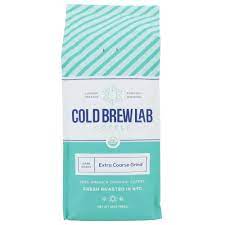
What Kind Of Coffee Beans Are Best For Cold Brew Coffee?
As a coffee lover I am very particular about my coffee beans. You are best to avoid expensive coffee like Kona Coffee, Coffee Yauco Selecto AA and Kopi Luwak. If any of these are your favorite coffee, I have bad news for you – they are not likely to work at all that well for cold brew coffee.
Coffee is full of complexities and some compare it to a fine wine. That is an unfair comparison as there are more variables with coffee and many different ways of brewing your coffee and many more things to consider, such as brewing time and, of course, temperature, grind size and so on.
Any slight adjustment in these can lead to a fuller body and flavor extraction.
Such complexities you don’t get with a wine – pour and serve!
One thing for sure, single-origin coffee is great for cold brew.
What Roast Is Best For Cold Brew?
When considering cold brew coffee beans, you need to take into account what roast is best for brewing cold brew coffee.
In all honesty, it is a personal choice and comes down to your personal preference.
Some coffee lovers enjoy a deep dark roast, which is fine, as dark roast coffee does work, and you can enjoy the nutty, chocolate notes and hints. Lighter roasts like a medium roast also makes for a very good cup of coffee with neat, floral notes that win out.
That is what makes my favorite Ethiopian coffee a great choice for cold brew. Something you need to be aware of is that lighter roasts need a longer extraction time.
What Grind Is Best For Cold Brew?
I always advise against buying pre-ground coffee for the reasons of freshness and enjoying the maximum flavor from what you are spending your money on. Whole bean coffee is always better, much better.
Due to the long extraction time and full immersion (or the Japanese drip method), a coarse coffee grind works best. You can also brew it with whole beans if you want to.
Brewing Time – The Ideal Brew Time For Cold Brew Coffee
Cold brew coffee, as you have figured, has a long brewing time, which is something that you simply cannot change or accelerate. Brew it today and enjoy it tomorrow. This is why it is a good idea for you to brew it in large batches.
You will need to steep your coarsely ground coffee beans for 12-24 hours.
If you are using the Japanese flash cold brew method with a cold drip coffee maker, it is likely that it will take you from 6 to 12 hours to brew.
Brewing Temperature And Conditions
The perfect brewing temperature is using water that is as close to the freezing point as you can possibly get and brewing your cold brew coffee in your fridge.
At the most – 3C to 5C (37F to 41F). Use clean, filtered water and an airtight container for best results.
Frequently Asked Questions About Cold Brew Coffee Beans
Are Cold Brew Coffee Beans Different?
No,
while some coffee beans are better than others for cold brew coffee and produce a different taste, there is no specific bean or roast. It all depends on what you, the coffee drinker, wants to achieve. Some roasts are better than others.
To be straight, cold brew coffee beans are not different.
Can You Cold Brew Whole Coffee Beans?
Yes,
you can brew whole coffee beans without grinding them. You will need to adjust the brew time to compensate and draw out their flavors. I suggest that you try it at least once and absolutely so if you are in an emergency situation when and if your coffee grinder is broken.
Why Is My Cold Brew Not Strong?
There are a few reasons why your cold brew is not strong. You may have used too much water and not adhered to the ideal or correct coffee to water ratio, used the wrong grind size or not brewed it for long enough.
Should I Brew Cold Brew In Fridge?
Yes,
I absolutely insist that you brew your cold brew coffee in the fridge. When you brew it in your fridge, you get your water at the lowest temperature and keep it at that low temperature while it is brewing and end up with a better quality cold brew.
Some coffee enthusiasts and experts like to brew at room temperature, but this only results in room temperature extractions and gives you issues with harsh lights that are detrimental to your coffee.
Brewing with ice-cold water and then brewing it in your fridge means that you are ensuring that you will extract only the low temperature compounds.
What Coffee Beans Are Good For Cold Brew?
As far as your options go, you have many choices. The best beans for a great cold brew coffee are premium quality dark roast coffee beans. You can drop to a medium-dark roast at most, but anything less your coffee will have too light a flavor to be enjoyable.
What Is The Difference Between Cold Brew Coffee Beans And Regular Coffee Beans?
There is no set or specific difference between a cold brew coffee beans and regular coffee beans. The difference is in the brewing method, and how the coffee beans are brewed.
The few beans that are marked or labeled as cold brew coffee beans are roasted in a specific way to ensure all the great milk coffee and chocolate notes are extracted at a low temperature and not a high temperature.
This skill is from the master roaster’s knowledge of both the beans and the roasting process.
Can You Cold Brew Any Coffee?
Yes, and coffee beans can be used to make cold brew coffee beans. As I have stated earlier, medium-dark to dark roast works best. Use a coarse ground coffee due to the long extraction time. Finely ground coffee beans will quickly over extract and become too bitter to enjoy.
Does Cold Brew Require Special Beans?
No, no special beans are needed for making a cold brew coffee. Use your favorite medium-dark or dark roast coffee beans and use a coarse grind.
Frappé-Ing It All Up – Cold Brew Coffee Beans
We have discussed the top 10 cold brew coffee beans in this article and included in this list two coffees that are specifically roasted for brewing cold brew and included a rather excellent decaf option from Lavazza.
If you are environmentally conscious – as we all should be we have detailed a couple of options too, and we have included a healthy option.
If you tried any of the beans above? Yes? Then let us know how your cold brew turned out or if you need help perfecting your brewing technique.
Join our cool coffee community and join in the conversation by telling us all about the amazing new beans that you are trying to make a cold brew coffee. Find us on Facebook/Meta.

